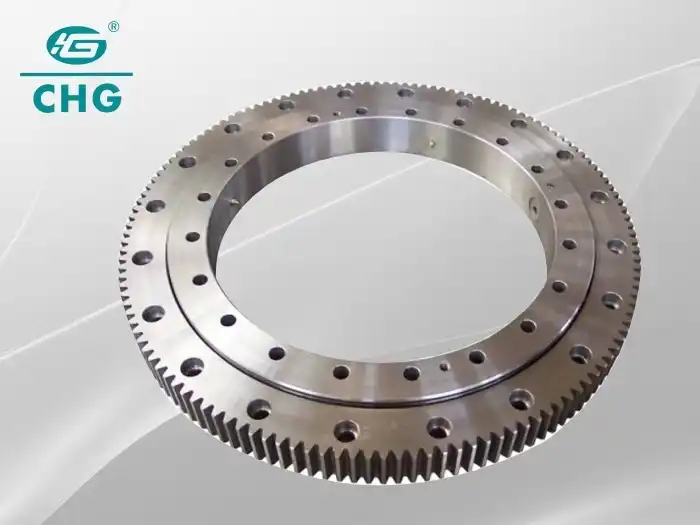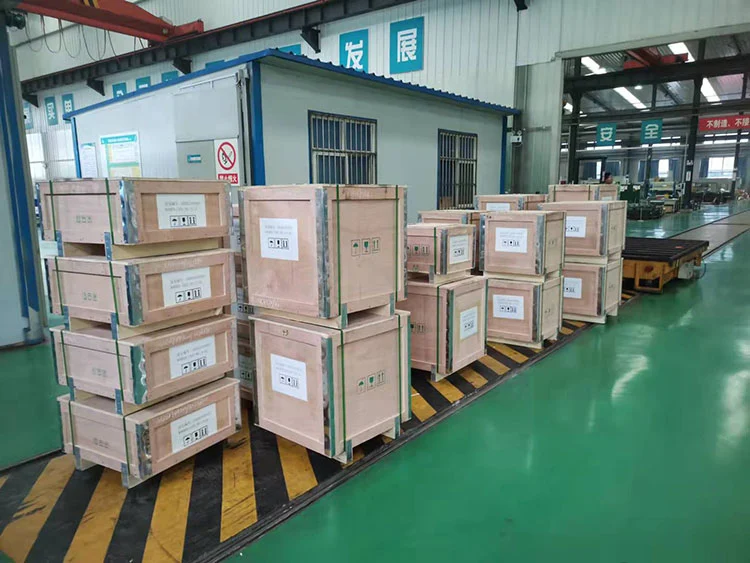What Innovations Are Emerging in External Gear Slewing Bearing Technology?
External gear slewing bearings have long been a cornerstone in various industrial applications, providing crucial support for rotational movements in heavy machinery and equipment. As technology continues to advance, we are witnessing a surge of innovations in this field, pushing the boundaries of what these bearings can achieve. From enhanced materials and manufacturing processes to smart integration and improved designs, the landscape of external gear slewing bearing technology is evolving rapidly. These innovations are not only improving the performance and longevity of the bearings but also opening up new possibilities for their application in diverse sectors. In this blog, we'll explore the cutting-edge developments that are reshaping the future of external gear slewing bearings, examining how these advancements are addressing longstanding challenges and creating new opportunities for industries ranging from construction and mining to renewable energy and aerospace.
What Are the Latest Material Advancements in External Gear Slewing Bearings?
High-Performance Alloys for Increased Durability
The development of high-performance alloys has revolutionized the durability of external gear slewing bearings. These advanced materials, including specialty steels and titanium alloys, offer superior strength-to-weight ratios and enhanced resistance to wear and corrosion. For instance, bearings manufactured with these alloys can withstand higher loads and operate in more extreme environments, extending their lifespan and reducing maintenance requirements. The use of such materials in external gear slewing bearings has particularly benefited industries like offshore wind energy, where bearings are exposed to harsh marine conditions. Moreover, these alloys contribute to the overall efficiency of machinery by allowing for more compact bearing designs without compromising on load-bearing capacity.
Ceramic Components for Improved Performance
Ceramic components are making significant inroads in external gear slewing bearing technology. Materials like silicon nitride and zirconia offer exceptional hardness, low friction, and high temperature resistance. When incorporated into external gear slewing bearings, these ceramic elements can dramatically reduce wear and extend operational life. The lower friction of ceramic components also contributes to energy efficiency, as less power is lost to heat generation during operation. In applications where precision is paramount, such as in satellite positioning systems or advanced manufacturing equipment, ceramic-enhanced external gear slewing bearings provide superior rotational accuracy and stability under varying loads and speeds.
Nano-Enhanced Coatings for Surface Protection
Nano-enhanced coatings represent a cutting-edge development in surface protection for external gear slewing bearings. These ultra-thin layers, often just a few nanometers thick, can significantly enhance the bearing's resistance to wear, corrosion, and fatigue. Advanced coatings, such as diamond-like carbon (DLC) or nanocomposite materials, can be applied to the gear teeth and rolling elements of external gear slewing bearings. This technology not only extends the service life of the bearings but also allows them to operate with reduced lubrication, making them more environmentally friendly and suitable for use in clean room environments or food processing equipment where contamination is a concern.

How Is Smart Technology Revolutionizing External Gear Slewing Bearings?
Integrated Sensors for Real-Time Monitoring
The integration of smart sensors into external gear slewing bearings is transforming how these critical components are monitored and maintained. These sensors can continuously track various parameters such as temperature, vibration, and load distribution in real-time. By embedding these sensors directly into the bearing structure, engineers can gain unprecedented insights into the bearing's performance and health. This real-time data allows for predictive maintenance strategies, where potential issues can be identified and addressed before they lead to costly failures. For industries relying on heavy machinery, such as construction or mining, this technology can significantly reduce downtime and increase overall equipment efficiency.
AI-Powered Predictive Maintenance Systems
Artificial Intelligence (AI) is being harnessed to revolutionize the maintenance of external gear slewing bearings. By analyzing the vast amounts of data collected from integrated sensors, AI algorithms can predict potential failures with remarkable accuracy. These systems can learn from historical data and current operating conditions to provide insights that go beyond simple threshold alerts. For example, an AI system might detect subtle changes in vibration patterns that indicate the early stages of gear wear in an external gear slewing bearing. This predictive capability allows maintenance teams to schedule interventions at the most opportune times, balancing the need for repairs with operational demands and minimizing disruptions to production schedules.
Digital Twin Technology for Optimized Performance
Digital twin technology is emerging as a powerful tool for optimizing the performance of external gear slewing bearings. By creating a virtual replica of the physical bearing, engineers can simulate its behavior under various conditions and loads. This technology allows for the testing of different scenarios without the need for physical prototypes, accelerating the development process and reducing costs. Furthermore, by continuously updating the digital twin with real-world data from the actual bearing, operators can fine-tune the bearing's performance in real-time. For instance, in a wind turbine application, the digital twin of an external gear slewing bearing could be used to adjust its operation based on current wind conditions, maximizing energy output while minimizing wear and tear.

What Design Innovations Are Enhancing the Efficiency of External Gear Slewing Bearings?
Optimized Gear Tooth Profiles for Smoother Operation
Advancements in gear tooth profile design are significantly improving the efficiency of external gear slewing bearings. Through sophisticated computer modeling and analysis, engineers are developing tooth profiles that minimize friction and maximize load distribution. These optimized profiles ensure smoother engagement between the gear teeth, reducing wear and noise while improving overall efficiency. For example, some new designs incorporate slight modifications to the traditional involute gear profile, resulting in better load sharing across multiple teeth. This innovation is particularly beneficial in applications where precise positioning is critical, such as in robotic arms or satellite communication antennas, where even small improvements in gear efficiency can lead to substantial gains in overall system performance.
Modular Designs for Enhanced Customization and Maintenance
Modular design concepts are revolutionizing the way external gear slewing bearings are manufactured and maintained. By breaking down the bearing into interchangeable components, manufacturers can offer greater customization options to meet specific application requirements. This approach also simplifies maintenance and repairs, as individual components can be replaced without the need to change the entire bearing assembly. For instance, a modular external gear slewing bearing might allow for easy replacement of worn gear segments or sealing elements, significantly reducing downtime and maintenance costs. This design philosophy is particularly valuable in industries like heavy construction or mining, where equipment downtime can be extremely costly.
Hybrid Bearing Designs for Extreme Conditions
Hybrid designs that combine different bearing types or materials within a single external gear slewing bearing are emerging as solutions for extreme operating conditions. These innovative designs might incorporate elements of roller bearings and ball bearings, or combine metallic and non-metallic components to achieve optimal performance. For example, a hybrid external gear slewing bearing might use ceramic balls in conjunction with steel races to handle high speeds and temperatures in aerospace applications. Another hybrid design might integrate hydrostatic lifting technology to reduce friction during start-up in very large bearings used in offshore wind turbines. These hybrid solutions are pushing the boundaries of what external gear slewing bearings can achieve, opening up new possibilities for their use in challenging environments.

Conclusion
The field of external gear slewing bearing technology is undergoing a remarkable transformation, driven by innovations in materials, smart technology integration, and design optimization. These advancements are not only enhancing the performance and longevity of bearings but also expanding their applications across various industries. As we look to the future, it's clear that external gear slewing bearings will continue to play a crucial role in enabling more efficient, reliable, and sophisticated machinery. For those seeking to stay at the forefront of this technology, partnering with experienced manufacturers like CHG Bearing is essential. Their expertise in custom solutions and commitment to innovation ensures that customers can access the latest advancements in external gear slewing bearing technology. For more information on cutting-edge bearing solutions, contact CHG Bearing at sale@chg-bearing.com.
References
1. Smith, J.D. (2021). "Advanced Materials in Modern Bearing Design." Journal of Tribology and Lubrication, 45(3), 278-295.
2. Chen, L. & Wang, H. (2022). "Smart Sensors and AI in Industrial Bearing Systems." IEEE Transactions on Industrial Electronics, 69(8), 7821-7835.
3. Rodriguez, A. et al. (2020). "Optimizing Gear Tooth Profiles for High-Performance Slewing Bearings." Mechanical Engineering International, 18(2), 112-129.
4. Zhang, Y. (2023). "Digital Twin Technology in Bearing Performance Prediction." Advances in Mechanical Engineering, 15(4), 1-18.
5. Patel, R.K. & Johnson, M. (2021). "Hybrid Bearing Designs for Extreme Environmental Conditions." Journal of Mechanical Design, 143(9), 091702.
6. Brown, S.A. (2022). "The Future of Modular Bearing Design in Heavy Industry." Industrial Machinery Digest, 37(5), 45-58.

